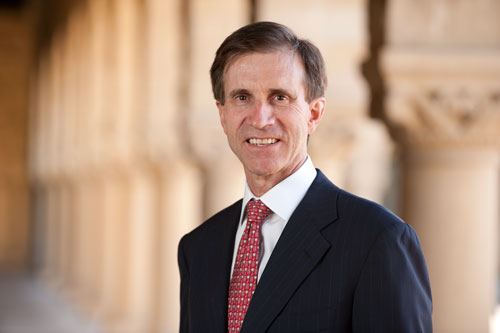Stanford’s CFO talks about his wellness regimen

RANDY LIVINGSTON, vice president for business affairs and chief financial officer, recently talked to the BeWell Program about the role fitness plays in his busy life, and how he sticks to his goals for wellness.
What do you do for exercise?
I like a variety of different activities. Cycling is my primary cardio exercise. I try to get out on the road 2-3 times per week, and a bit more often in the summertime. My typical ride is 15-35 miles including some hills.
I also try to get to the gym to lift weights twice per week, and I walk between meetings on campus, with our dog at home, and I hike in the local hills and Sierra.
I enjoy golf, despite my high handicap! In the winter, I ski about 20 days per year, both alpine and cross-country.
What motivates you?
A few years ago, the BeWell program provided free copies of the book, Younger Next Year, that described the medical benefits of exercise for a wide range of diseases — cardiovascular, cancer and neurological. I was already a regular exerciser, but after reading the book I became more of a zealot. I truly believe that regular exercise is the best medicine for good health. My grandmother and uncle both died of Alzheimer’s disease and my mother is showing early signs, so I’m worried about being predestined for it. I’ve heard Dr. Frank Longo, chair of the Department of Neurology, recommend exercise as the best current remedy to stave off the onset of Alzheimer’s.
In addition, exercise is fun for me. We live in the best place in the world for cycling, with an incredible range of beautiful rides and perfect weather most of the year. We also have the blessing of tons of open space all over the Bay Area, with a wide variety of great hikes.
There are a limited number of hours in the day. How do you make time for work and wellness?
I schedule time for exercise, just like any other activity on my calendar. If I don’t schedule it, the time gets chewed up with meetings or email. Specifically, I do an early morning bike ride one or two mornings a week before work. Often, I’ll work on a presentation or discussion in my head during a ride. During the spring and summer, I commute to work once or twice a week on my bike. I also try to stop by the gym on the way home once per week. And I get some kind of vigorous exercise each day on the weekends. When I exercise, I have more energy at work and need less sleep, so I don’t really feel like I’m sacrificing work time for exercise.
What is your biggest barrier to wellness?
I love to eat and I have a huge sweet tooth, and I have a hard time resisting dessert. Fortunately, I can pretty much eat as much as I want, and I weigh about the same as when I graduated high school. I’m not sure if it’s because of the amount of exercise I get or my microbiome, and I don’t want to do the experiment of stopping exercise to find out. Stanford Medicine published an article recently on research led by Dr. URI LADABAUM indicating that obesity is more a function of lack of exercise than diet. I’m an adherent of that view.
What would you say is the key to your success?
Making exercise a habit is key. When I go a couple of days without exercise, I miss the endorphin high — and that motivates me to get out and do something. I also get a lot of support from my wife and friends. My wife and I often come to campus Saturday mornings to walk our dog and then go to the gym together. I have 20-30 cycling friends that ride together every Sunday morning. The social interaction is a big part of my motivation to keep doing it.
… any closing thoughts?
Stanford makes it so easy to get regular exercise with our incredible facilities, HIP and BeWell programs, and campus. I’m disappointed when I see fellow employees driving carts between meetings on campus, as they are forgoing an easy exercise opportunity. With the advent of mobile devices, I can even catch up on email as I walk across campus.

